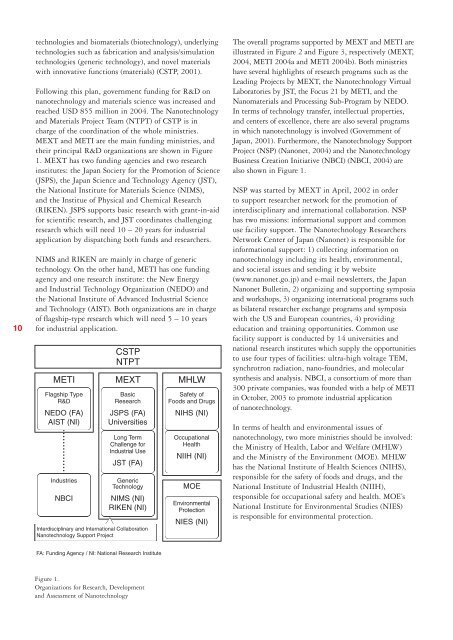Small size - large impact - Nanowerk
Small size - large impact - Nanowerk
Small size - large impact - Nanowerk
You also want an ePaper? Increase the reach of your titles
YUMPU automatically turns print PDFs into web optimized ePapers that Google loves.
10<br />
technologies and biomaterials (biotechnology), underlying<br />
technologies such as fabrication and analysis/simulation<br />
technologies (generic technology), and novel materials<br />
with innovative functions (materials) (CSTP, 2001).<br />
Following this plan, government funding for R&D on<br />
nanotechnology and materials science was increased and<br />
reached USD 855 million in 2004. The Nanotechnology<br />
and Materials Project Team (NTPT) of CSTP is in<br />
charge of the coordination of the whole ministries.<br />
MEXT and METI are the main funding ministries, and<br />
their principal R&D organizations are shown in Figure<br />
1. MEXT has two funding agencies and two research<br />
institutes: the Japan Society for the Promotion of Science<br />
(JSPS), the Japan Science and Technology Agency (JST),<br />
the National Institute for Materials Science (NIMS),<br />
and the Institue of Physical and Chemical Research<br />
(RIKEN). JSPS supports basic research with grant-in-aid<br />
for scientific research, and JST coordinates challenging<br />
research which will need 10 – 20 years for industrial<br />
application by dispatching both funds and researchers.<br />
NIMS and RIKEN are mainly in charge of generic<br />
technology. On the other hand, METI has one funding<br />
agency and one research institute: the New Energy<br />
and Industrial Technology Organization (NEDO) and<br />
the National Institute of Advanced Industrial Science<br />
and Technology (AIST). Both organizations are in charge<br />
of flagship-type research which will need 5 – 10 years<br />
for industrial application.<br />
CSTP<br />
NTPT<br />
METI MEXT MHLW<br />
Flagship Type<br />
R&D<br />
NEDO (FA)<br />
AIST (NI)<br />
Industries<br />
NBCI<br />
Basic<br />
Research<br />
JSPS (FA)<br />
Universities<br />
Long Term<br />
Challenge for<br />
Industrial Use<br />
JST (FA)<br />
Generic<br />
Technology<br />
NIMS (NI)<br />
RIKEN (NI)<br />
Interdisciplinary and International Collaboration<br />
Nanotechnology Support Project<br />
Safety of<br />
Foods and Drugs<br />
NIHS (NI)<br />
Occupational<br />
Health<br />
NIIH (NI)<br />
MOE<br />
Environmental<br />
Protection<br />
NIES (NI)<br />
The overall programs supported by MEXT and METI are<br />
illustrated in Figure 2 and Figure 3, respectively (MEXT,<br />
2004, METI 2004a and METI 2004b). Both ministries<br />
have several highlights of research programs such as the<br />
Leading Projects by MEXT, the Nanotechnology Virtual<br />
Laboratories by JST, the Focus 21 by METI, and the<br />
Nanomaterials and Processing Sub-Program by NEDO.<br />
In terms of technology transfer, intellectual properties,<br />
and centers of excellence, there are also several programs<br />
in which nanotechnology is involved (Government of<br />
Japan, 2001). Furthermore, the Nanotechnology Support<br />
Project (NSP) (Nanonet, 2004) and the Nanotechnology<br />
Business Creation Initiative (NBCI) (NBCI, 2004) are<br />
also shown in Figure 1.<br />
NSP was started by MEXT in April, 2002 in order<br />
to support researcher network for the promotion of<br />
interdisciplinary and international collaboration. NSP<br />
has two missions: informational support and common<br />
use facility support. The Nanotechnology Researchers<br />
Network Center of Japan (Nanonet) is responsible for<br />
informational support: 1) collecting information on<br />
nanotechnology including its health, environmental,<br />
and societal issues and sending it by website<br />
(www.nanonet.go.jp) and e-mail newsletters, the Japan<br />
Nanonet Bulletin, 2) organizing and supporting symposia<br />
and workshops, 3) organizing international programs such<br />
as bilateral researcher exchange programs and symposia<br />
with the US and European countries, 4) providing<br />
education and training opportunities. Common use<br />
facility support is conducted by 14 universities and<br />
national research institutes which supply the opportunities<br />
to use four types of facilities: ultra-high voltage TEM,<br />
synchrotron radiation, nano-foundries, and molecular<br />
synthesis and analysis. NBCI, a consortium of more than<br />
300 private companies, was founded with a help of METI<br />
in October, 2003 to promote industrial application<br />
of nanotechnology.<br />
In terms of health and environmental issues of<br />
nanotechnology, two more ministries should be involved:<br />
the Ministry of Health, Labor and Welfare (MHLW)<br />
and the Ministry of the Environment (MOE). MHLW<br />
has the National Institute of Health Sciences (NIHS),<br />
responsible for the safety of foods and drugs, and the<br />
National Institute of Industrial Health (NIIH),<br />
responsible for occupational safety and health. MOE’s<br />
National Institute for Environmental Studies (NIES)<br />
is responsible for environmental protection.<br />
FA: Funding Agency / NI: National Research Institute<br />
Figure 1.<br />
Organizations for Research, Development<br />
and Assessment of Nanotechnology
















